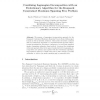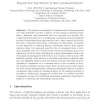101 search results - page 3 / 21 » Fast Comparison of Evolutionary Trees |
CORR
2007
Springer
13 years 7 months ago
2007
Springer
Abstract—Phylogenetic networks are a generalization of phylogenetic trees that allow for the representation of non-treelike evolutionary events, like recombination, hybridization...
EVOW
2007
Springer
14 years 1 months ago
2007
Springer
We present a Lagrangian decomposition approach for the Knapsack Constrained Maximum Spanning Tree problem yielding upper bounds as well as heuristic solutions. This method is furth...
GECCO
2004
Springer
14 years 25 days ago
2004
Springer
Permutations of vertices can represent constrained spanning trees for evolutionary search via a decoder based on Prim’s algorithm, and random keys can represent permutations. Tho...
ISBRA
2010
Springer
13 years 5 months ago
2010
Springer
The random accumulation of variations in the human genome over time implicitly encodes a history of how human populations have arisen, dispersed, and intermixed since we emerged as...
CCECE
2006
IEEE
14 years 1 months ago
2006
IEEE
Phylogenetic trees are commonly reconstructed based on hard optimization problems such as Maximum parsimony (MP) and Maximum likelihood (ML). Conventional MP heuristics for produc...


